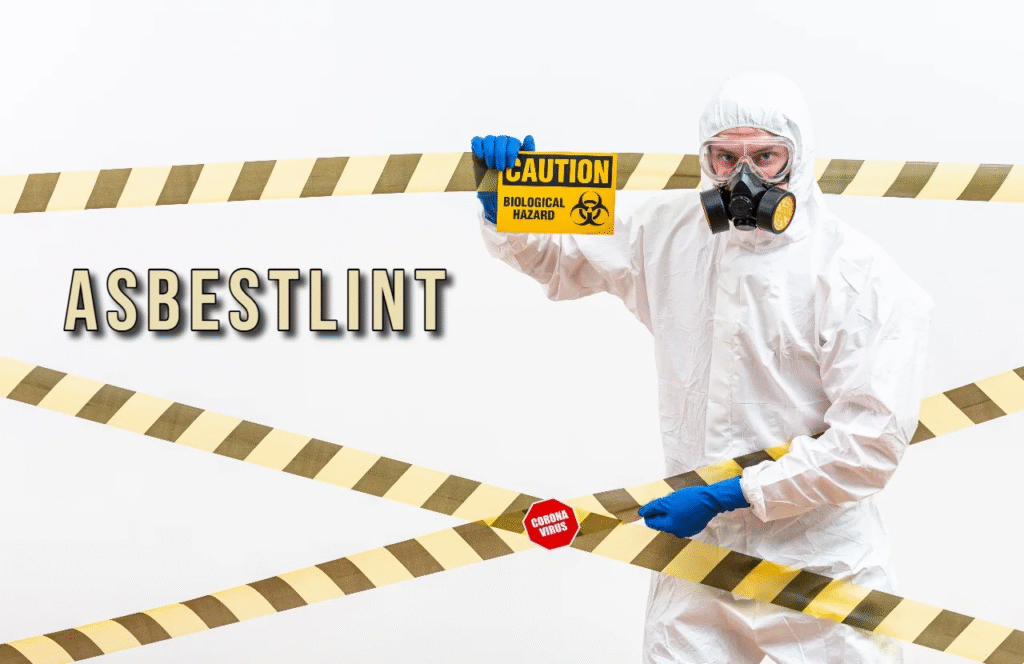Asbestlint: Understanding the Risks and Applications of Asbestos Tape
Asbestlint, commonly known as asbestos tape, is a material that contains asbestos fibers, which were historically used for various industrial applications. This material is primarily known for its heat resistance, making it suitable for use in insulation, sealing, and fireproofing. However, the health risks associated with asbestos exposure, including lung cancer, asbestosis, and mesothelioma, have led to increasing regulations and a shift away from its use in recent decades.
In this comprehensive guide, we will explore everything you need to know about asbestlint, from its history and properties to the health risks it poses, its current uses, and alternatives that are safer for both workers and consumers. This article will be informative, easy to understand, and designed to provide value by addressing all aspects of asbestlint, so you can make informed decisions about its use and potential dangers.
What is Asbestlint?
Asbestlint, also known as asbestos tape, is a material made from asbestos fibers that is typically used for insulation and sealing purposes. Asbestos fibers are naturally occurring minerals that have heat-resistant properties, making them ideal for a range of industrial applications, especially in construction and manufacturing.
Historically, asbestlint was used in industries where high temperatures were common, such as in heating systems, boilers, and electrical insulation. It was valued for its durability, flexibility, and resistance to heat and fire. The tape was often wrapped around pipes, ducts, and other surfaces that required insulation or protection from heat.
Despite its widespread use, the dangers of asbestos exposure became more apparent over time. The inhalation of asbestos fibers can cause serious health problems, and this has led to the decline in the use of asbestlint and other asbestos-containing products.

The History of Asbestlint and Asbestos Usage
The use of asbestos dates back to ancient times, where it was prized for its durability and heat resistance. In the 20th century, especially after World War II, the material saw widespread industrial use. Asbestos was used in a variety of products, including construction materials, automotive parts, insulation, and textiles.
Asbestlint, or asbestos tape, became popular in the mid-20th century due to its effectiveness in insulating pipes, boilers, and other high-heat systems. The material was often wrapped around pipes in industrial and commercial settings to prevent heat loss and improve energy efficiency.
However, as studies began to reveal the dangerous health effects associated with asbestos exposure, the material’s popularity started to wane. Inhalation of asbestos fibers has been linked to several serious diseases, including lung cancer, asbestosis, and mesothelioma, a rare and aggressive cancer. As a result, regulations were introduced in many countries, including the United States, to limit and eventually ban the use of asbestos-containing products.
How Does Asbestlint Work?
Asbestlint, like other asbestos-containing materials, works by harnessing the heat-resistant properties of asbestos fibers. The fibers themselves are composed of tiny, needle-like structures that are capable of withstanding extremely high temperatures. When used as a tape, asbestlint is applied to surfaces that need insulation or protection from heat.
The primary function of asbestlint is to act as an insulating barrier. For example, it could be wrapped around pipes to prevent heat loss, reduce condensation, or protect against fire hazards. The tape’s flexible nature allows it to conform to various shapes, making it ideal for use in tight spaces or around complex systems. It can also provide a protective layer against the heat generated by machinery or electrical systems.
In addition to heat resistance, asbestlint also provides durability and long-lasting protection. It resists degradation from both high temperatures and environmental factors, making it a reliable material for industrial settings.
Health Risks Associated with Asbestos Exposure
The health risks associated with asbestos exposure are severe and well-documented. Inhaling asbestos fibers can cause a variety of respiratory and cardiovascular diseases, including:
A. Asbestosis
Asbestosis is a chronic lung disease caused by the inhalation of asbestos fibers. The fibers can scar the lung tissue, leading to difficulty breathing, coughing, and chest pain. Asbestosis is a progressive condition, meaning it worsens over time, and there is no cure.
B. Lung Cancer
Asbestos exposure is a known cause of lung cancer, and the risk is higher for individuals who smoke and have been exposed to asbestos. The fibers can cause mutations in lung cells, leading to cancer. Symptoms of lung cancer include coughing, weight loss, shortness of breath, and chest pain.
C. Mesothelioma
Mesothelioma is a rare and aggressive cancer that affects the lining of the lungs, heart, or abdomen. It is almost exclusively caused by asbestos exposure, and symptoms may not appear until decades after exposure. Mesothelioma has a poor prognosis and is often diagnosed at an advanced stage.
D. Other Health Effects
In addition to the conditions mentioned above, asbestos exposure has also been linked to other diseases, including pleural plaques (thickening of the lining of the lungs), lung fibrosis, and even digestive system cancers.
Regulations and Bans on Asbestos in the United States
Due to the health risks associated with asbestos, the United States has implemented strict regulations to limit exposure and protect workers and the public. The most notable regulatory body overseeing asbestos in the U.S. is the Occupational Safety and Health Administration (OSHA), which has established exposure limits for asbestos in the workplace.
A. The Clean Air Act (1970)
The Clean Air Act played a significant role in limiting asbestos exposure by setting standards for air quality, including limiting the amount of asbestos fibers that could be released into the air during manufacturing and industrial processes.
B. The Toxic Substances Control Act (TSCA) (1976)
The TSCA was another key piece of legislation that allowed the Environmental Protection Agency (EPA) to regulate the use of toxic substances, including asbestos. Asbestos was gradually phased out of many applications, with some exceptions for specific uses, such as in asbestos-containing roofing materials and certain automotive products.
C. Complete Ban of Asbestos (1990s)
While asbestos use in the U.S. has not been entirely banned, the EPA attempted to impose a total ban on asbestos-containing products in the 1990s. However, legal challenges from the asbestos industry delayed the implementation of the ban. While the use of asbestlint and other asbestos-containing products has been drastically reduced, asbestos is still present in some older buildings and industrial equipment.
Safe Handling and Removal of Asbestlint
If you come across asbestlint or any other asbestos-containing materials, it is crucial to handle them with care. In many cases, older buildings and equipment may still contain materials like asbestlint, posing potential health risks if disturbed. Here are some guidelines for handling and removing asbestos safely:
A. Professional Removal
The safest way to handle asbestos-containing materials is to hire a professional asbestos removal company. These companies are trained in handling and disposing of asbestos safely and can ensure that the removal process complies with local regulations.
B. Personal Protective Equipment (PPE)
If you must work with asbestlint or other asbestos-containing materials, it is essential to wear appropriate personal protective equipment, including a high-efficiency particulate air (HEPA) respirator, protective clothing, and gloves. This will help reduce the risk of inhaling asbestos fibers during handling.
C. Proper Disposal
Asbestos waste must be disposed of in accordance with local environmental regulations. It should be placed in clearly labeled, leak-proof containers and transported to a certified disposal facility that handles hazardous waste.
D. Avoid Disturbing Asbestos Materials
If you find asbestlint or other asbestos-containing materials that are intact and undamaged, it is generally safer to leave them undisturbed. Disturbing these materials can release harmful asbestos fibers into the air.
Alternative Insulation Materials to Asbestlint
Due to the dangers of asbestos, many industries have shifted to safer alternatives for insulation and sealing. Some of the most commonly used alternatives to asbestlint include:
A. Fiberglass Insulation
Fiberglass is a popular alternative to asbestos because it is non-toxic, fire-resistant, and effective at insulating. It is widely used in construction and manufacturing for both thermal and acoustic insulation.
B. Mineral Wool
Mineral wool, also known as rock wool, is another non-toxic alternative to asbestos. It is made from natural rocks and minerals and is used for insulation, fireproofing, and soundproofing. Mineral wool is an excellent choice for high-heat applications and is considered a safer option than asbestos.
C. Ceramic Fiber
Ceramic fiber is a high-temperature insulation material that is often used in industries that require extreme heat resistance. It is non-toxic and safe to use, making it a suitable replacement for asbestos in many applications.
How to Identify Asbestlint in Older Buildings
Identifying asbestlint in older buildings can be challenging because it may be hidden beneath layers of insulation or behind walls. However, if you suspect that a material may contain asbestos, here are some steps you can take:

A. Check the Age of the Building
Buildings constructed before the 1980s are more likely to contain asbestos materials. Asbestlint is commonly found in older heating systems, boilers, and pipes.
B. Look for Visible Signs
Asbestlint often appears as a white, grey, or light-colored tape. It may be wrapped around pipes or ducts and may have a fibrous texture. If the material is old and deteriorating, it may release asbestos fibers into the air.
C. Hire a Professional Inspector
If you’re unsure whether a material contains asbestos, it is recommended to hire a professional asbestos inspector. They can conduct tests and determine whether the material is hazardous.
Conclusion
Asbestlint, or asbestos tape, was once a widely used material in various industries due to its heat-resistant properties. However, the health risks associated with asbestos exposure have led to stricter regulations and a decline in its use. Today, while asbestlint is no longer used in most applications, it can still be found in older buildings and industrial equipment, posing a potential risk to those who come into contact with it.
If you encounter asbestlint or other asbestos-containing materials, it is essential to handle them with care and to seek professional assistance for removal and disposal. Asbestos-free alternatives, such as fiberglass, mineral wool, and ceramic fiber, provide safer options for insulation and fireproofing.
By understanding the risks and following proper safety protocols, you can protect yourself and others from the dangers of asbestos while still maintaining the functionality and safety of your home or workplace.
Frequently Asked Questions (FAQs) about Asbestlint
Is asbestlint still used today?
No, asbestlint is no longer widely used due to the health risks associated with asbestos exposure. However, it may still be found in older buildings or industrial equipment.
How can I safely remove asbestlint from my home or workplace?
It is recommended to hire a professional asbestos removal company to safely remove asbestlint. They are trained in proper handling and disposal techniques.
What should I do if I find asbestlint in my home?
If you find asbestlint or other asbestos-containing materials, avoid disturbing them and contact a professional asbestos inspector for advice on how to proceed.
Are there any asbestos-free alternatives to asbestlint?
Yes, alternatives like fiberglass, mineral wool, and ceramic fiber are commonly used as safer replacements for asbestlint in insulation and fireproofing applications.
What are the health risks of being exposed to asbestlint?
Exposure to asbestos fibers can lead to serious health conditions, including asbestosis, lung cancer, and mesothelioma.
editor's pick
latest video
news via inbox
Nulla turp dis cursus. Integer liberos euismod pretium faucibua





